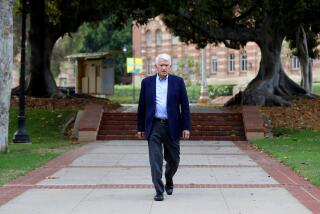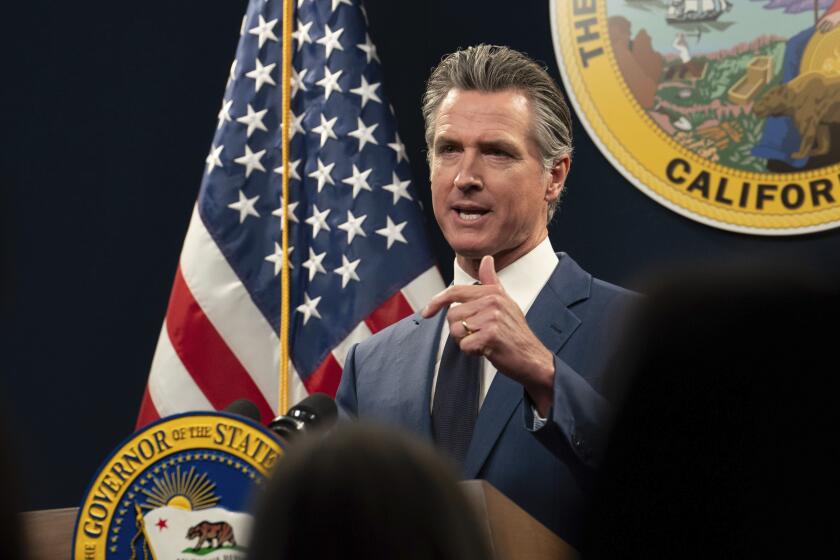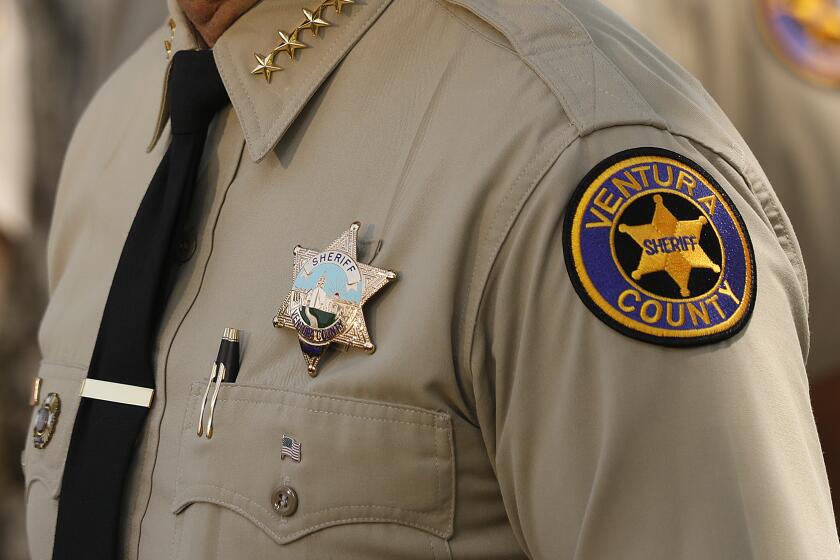A standoff over LAPD oversight
The LAPD still needs policing ALTHOUGH THE consent decree (pdf) to reform the Los Angeles Police Department has been in place for almost five years, many of its requirements still have not been met. That’s why the federal court must extend it, in its entirety, for at least two more years. The decree was approved by the city in 2000 — in the wake of the Rampart Division scandal — after an investigation by the U.S. Department of Justice found a “pervasive pattern” of constitutional-rights violations by the LAPD. The city signed on — promising to reform many aspects of the LAPD — in order to avoid a federal lawsuit. The consent decree was crucial because, for decades, study after study had documented abuses by LAPD officers, but serious reform had never occurred. The pattern for the last 40 years has been consistent and disturbing. A highly publicized incident — a beating, say, or a shooting — involving misconduct by LAPD officers occurs, followed by an in-depth study proposing major changes. Some recommendations are adopted, but many are ignored. The city declares victory until the next incident, and the cycle begins again. The Watts riots, the fatal shooting of Eulia Love in the 1970s, the Rodney King beating in 1991 and most recently Rampart — all fit this pattern exactly. The consent decree is vital because it requires reforms (rather than merely recommending them), creates an independent monitor to report on compliance and puts ultimate enforcement in the hands of a federal judge. Never before has the LAPD been mandated to make changes, nor has there been a mechanism to ensure that it does so. Much of the consent decree has been implemented; according to the LAPD itself, the department has complied with 149 of the 191 consent decree mandates. Unfortunately, some of the most important requirements of the consent decree have not yet been met. Most notably, the computerized system for tracking officers’ disciplinary records — the TEAMS II system — still does not exist. This has been called the “heart and soul” of the consent decree by District Judge Gary A. Feess, who is assigned the case. The TEAMS II system will establish a computerized record of every officer’s use-of-force incidents, citizen complaints, traffic accidents and other data; it will not only help in evaluating and assigning officers but also in measuring the department’s overall success in meeting its goals. Other key aspects of the consent decree, such as the nondiscrimination requirements, have yet to be fulfilled. Indeed, the data collected regarding motor vehicle and pedestrian stops show continuing bias. Initial data from 2002 documented that black and Latino motorists were still nearly three times more likely than white motorists to be asked to step out of their vehicles, four times more likely to be patted down and four times more likely to be asked to submit to a search. Subsequent data in 2005 showed that this pattern continues. On Friday, the city of Los Angeles and the Justice Department asked the court to extend portions of the consent decree for two years. Although this is a step in the right direction, they are wrong in asking for only some of it to remain in effect. For example, it is inexplicable that they want to discontinue the provision that requires senior officers not to discourage the filing of complaints, a serious problem documented by many. There is no cost to the city from continuing a provision like this. Most troubling, they would phase out the independent monitor over the next year and have the Police Commission’s inspector general take over responsibility for assessing compliance — even though the inspector general’s office is demonstrably not yet ready for that task. An independent assessment of the LAPD’s performance is crucial, and the monitor — Michael Cherkasky, who was appointed by the federal court — has revealed serious deficiencies within the inspector general’s office. Until the inspector general has fully complied with consent decree requirements and shown an ability to perform full and fair independent reviews, the city needs external oversight from the independent monitor. There is no reason to let the consent decree lapse, and there are compelling reasons to continue it. Everyone benefits by the assurance that the long-overdue changes in the LAPD will occur. ERWIN CHEMERINSKY is a professor of law and political science at Duke University. CATHERINE LHAMON is the racial justice director of the ACLU of Southern California and MARK ROSENBAUM is its legal director. | We’ve changed WHEN I BECAME CHIEF of police 3 1/2 years ago, I promised the people of Los Angeles that the LAPD would do three things: reduce crime, protect the city from terrorists and reform the character and style of our policing.
Owing in large part to the extraordinary efforts of our officers, we have reduced crime every year since then. Today, Los Angeles, on a per capita basis, is the nation’s second-safest large city. In the last year, serious crime has fallen to its lowest point since 1956, while arrests have steadily increased. With the assistance of the mayor and the City Council, the Los Angeles Police Department also has broadened and deepened its capacity to prevent terrorism. It is not enough, however, to drive down crime and to interdict terrorist threats. The police must do so consistently, compassionately and constitutionally. We have made tremendous strides in our quest to reform this department’s culture, policies and practices, and the work is ongoing. This process has been driven largely by the consent decree the city worked out with the U.S. Department of Justice in 2001, a year and a half before I was appointed chief. Some people have recommended that the entire decree be extended by two years — beyond the June 15 expiration date — saying that the LAPD is unwilling or unable to adhere to its reform agenda. This is just plain wrong. As we are struggling to become more open, the pundits appear to have become more myopic. Let me set the record straight. The men and women of the LAPD largely have embraced the tenets of the consent decree, realizing that many of its requirements formalized findings of an earlier, internal process and have greatly improved the organization. The vast majority of the reforms are now part and parcel of LAPD policy. This is a new LAPD. Fully one-third of our officers have been hired since the consent decree was implemented in 2001, and more than two-thirds have joined the department since 1995, when the Justice Department began its investigation. So, a significant percentage of our officers accept these “new” practices as normal operating procedure. Among the changes: watch commander review of arrestees and booking charges, stringent selection standards for anti-gang and field training officers and creation of a specialized division to investigate uses of force. The reform process has become an ongoing conversation involving the police, city leaders, the federal monitor and the judge. In most areas, particularly those involving the investigation and resolution of citizen complaints, the department, the civilian Police Commission and its inspector general and our federal partners have agreed that real reform is taking place. The LAPD is now recognized worldwide as a leader in “best practices policing.” We are regularly asked to provide advice on topics such as police performance auditing, ethical decision-making and supervisory training. In terms of the investigation of police shootings — down to half what they were in 1995 — the LAPD’s review and investigation procedures are widely considered to be state-of-the-art. The department continually reinforces its commitment to transparency of operations by maintaining an ongoing dialogue with community and civil rights groups and by posting all audits, monitor reports and Police Commission findings on our website (www.lapdonline.org). We are committed to completing TEAMS II, a computerized system for tracking officers’ disciplinary records, which will serve as a prototype for similar systems throughout the country. Its scale and ambition have presented formidable technical challenges. However, the pace is reflective of the careful consideration that has gone into the process and does not represent a failure or lack of willingness to implement reform. The LAPD also seeks to outfit every patrol car with a video camera in order to provide an objective view of our transactions with the public and to promote a sense of openness and cooperation with the community. The LAPD has learned from the past and is ready to take on the mantle of accountability the community expects of its police department. We are committed to openness, dialogue and best policing practices aimed at making Los Angeles the safest large city in the nation. WILLIAM J. BRATTON is chief of the Los Angeles Police Department. |
More to Read
Start your day right
Sign up for Essential California for news, features and recommendations from the L.A. Times and beyond in your inbox six days a week.
You may occasionally receive promotional content from the Los Angeles Times.
 Chief Bratton: ‘This is a new LAPD.’
Chief Bratton: ‘This is a new LAPD.’





